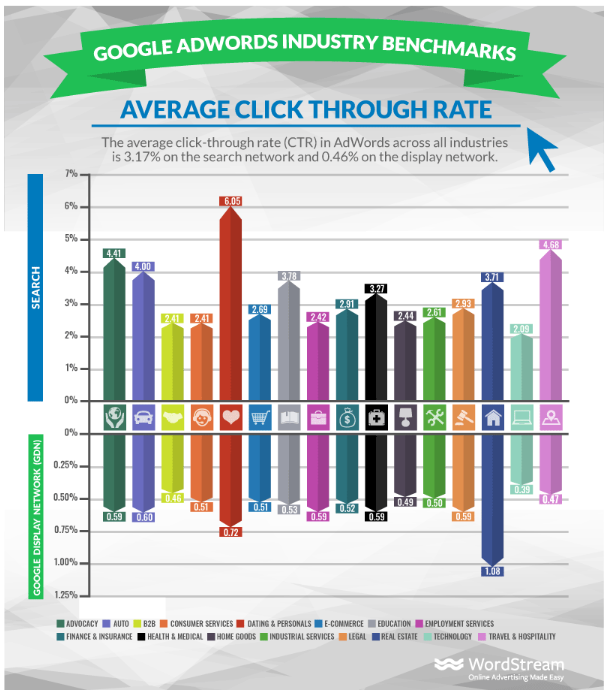Your click-through content can help you understand what people think of your ads and your content. Here’s how to understand the definition of good CTR along with the latest benchmarks.
PPC (pay per click) advertising can help you increase the traffic to your site while reaching new prospect clients. The click-through rate (CTR) is a good indication of the interest your ads are attracting and the actual clicks they are having.
The calculation of CTR is the number of clicks received divided by the number of impressions. For example, if your latest ad had 100 clicks in 10000 impressions, then your click-through-rate would be 1%.
Why is CTR important?
Your CTR indicates the relevance of your ads. The measurement of the impressions is not enough to tell you if your ad was interesting enough to gather clicks from your target audience. However, your CTR takes into consideration the number of impressions along with the actual clicks to the ads. Thus, it helps you improve the copy and the type of ads that you’re creating.
It can also help you be more effective with your marketing strategy by comparing the CTR and the budget that you’re using for every channel.
When it comes to testing, there are many factors that can affect your CTR. Some of them include:
- Channels you’re using
- B2B vs B2C
- Audience targeting
- Ad copy
- Keyword targeting
- Visual assets
- Different industries
- Business goals
These factors can affect the definition of a “good CTR” but we can still focus on the benchmarking of every channel to get an idea of what counts as a good click-through rate.
Google Search
The average click-through rate in Adwords across all industries is between 2.69% and 3.17% based on two different benchmarking reports from Wordstream and Adstage. This rate is quite encouraging but it’s useful to consider that the ranking and the success in Adwords comes along with great competition and many factors that will affect your results. Still, it’s certainly a marketing channel that cannot be ignored.
[Snippet of this infographic by WordStream, updated April 2019]
Bing Search
Bing Search had an average CTR of 3.11% in Q4 2018. Google might be the frontrunner in search but Bing should not be overlooked as a great option to highlight your brand’s content.
Google Display
Google’s display ads had an average CTR of 0.41% in Q4 2018.
When it comes to comparing the different results between search and display ads, it’s useful to remember that the display ads ten to be more general. The intent is not as strong in display ads, which means that the goal of awareness is keeping the CTR lower.
Facebook Newsfeed
The average CTR in Facebook’s newsfeed reached 1.46% in Q4 2018. Although it’s not a bad rate, it’s interesting that it saw a significant drop from Q4 2017 when it reached 2.4%.
The growing competition in Facebook’s newsfeed is making it harder to maintain an equally high CTR year-over-year. However, there are still many different placements on Facebook that you can try out to find success for your brand.
Facebook Audience Network
If you are interested in creating placements in Facebook’s Audience Network then it’s good to keep in mind that the average CTR is 1.40%
Facebook Messenger
Ads are becoming more popular on Facebook Messenger. The increasing competition has pushed the average CTR at 0.67%, which is decreased by 32% from last year.
When it comes to Facebook, the biggest challenge is to understand your audience and the placement that you’re picking to run the most appropriate A/B tests in your campaigns.
Instagram makes another placement to consider through Facebook’s Ads Manager. Its average CTR was 0.62% for Q4 2018. The growing competition in landing Instagram ads on users’ newsfeeds is making it harder to get your message out. However, Instagram is an engaging platform that more people are using on a regular basis. This means that it might be worth the effort while it’s currently trending.
YouTube
YouTube ads saw an average CTR of 0.24% in Q4 2018. The percentage is almost similar to Q4 2017, which means that it can serve as an established rate for your benchmarking before creating your next YouTube ads.
LinkedIn ads saw an average CTR of 0.26% in Q4 2018. The platform is heading towards a revival of its organic services and thus, the ads are also growing. In fact, there was an increase of 36.7% from Q3 2018.
Twitter ads are not always the first social ads that you might create but the CTR is encouraging landing at 1.55% in Q4 2018.
Overview
All these benchmarks can give you an idea of the average definition of a “good CTR” for every channel. However, your ultimate ad performance depends on many factors. Different industries and objectives can lead to varying results.
It’s still useful though to analyse the performance of each channel before deciding on the ones that might be more relevant for your business.
You don’t need to aim for the highest possible CTR as long as you achieve at least an average that doesn’t actually harm your ad’s performance.
A low CTR can reduce your Quality Score, which can affect the performance of your future ads. That’s why you need to create more relevant ads that combine effective copy and visuals that are interesting for your target audience.
Last but not least, keep in mind that your CTR is the first step towards a conversion. A high CTR does not necessarily guarantee a good return on investment for the ads. Right after testing your ads for the best CTR make sure that your landing pages, your copy and your website is also converting to ensure that you keep your visitors engaged.

